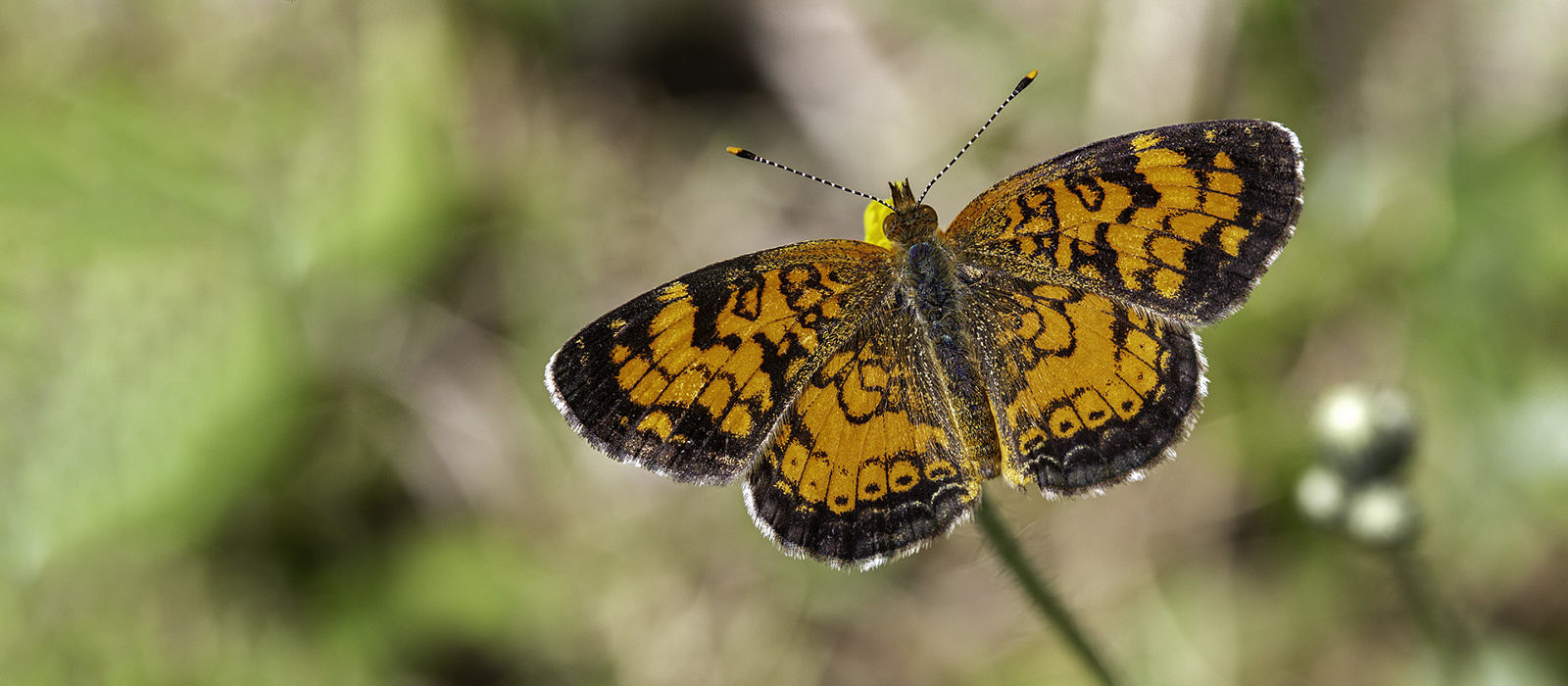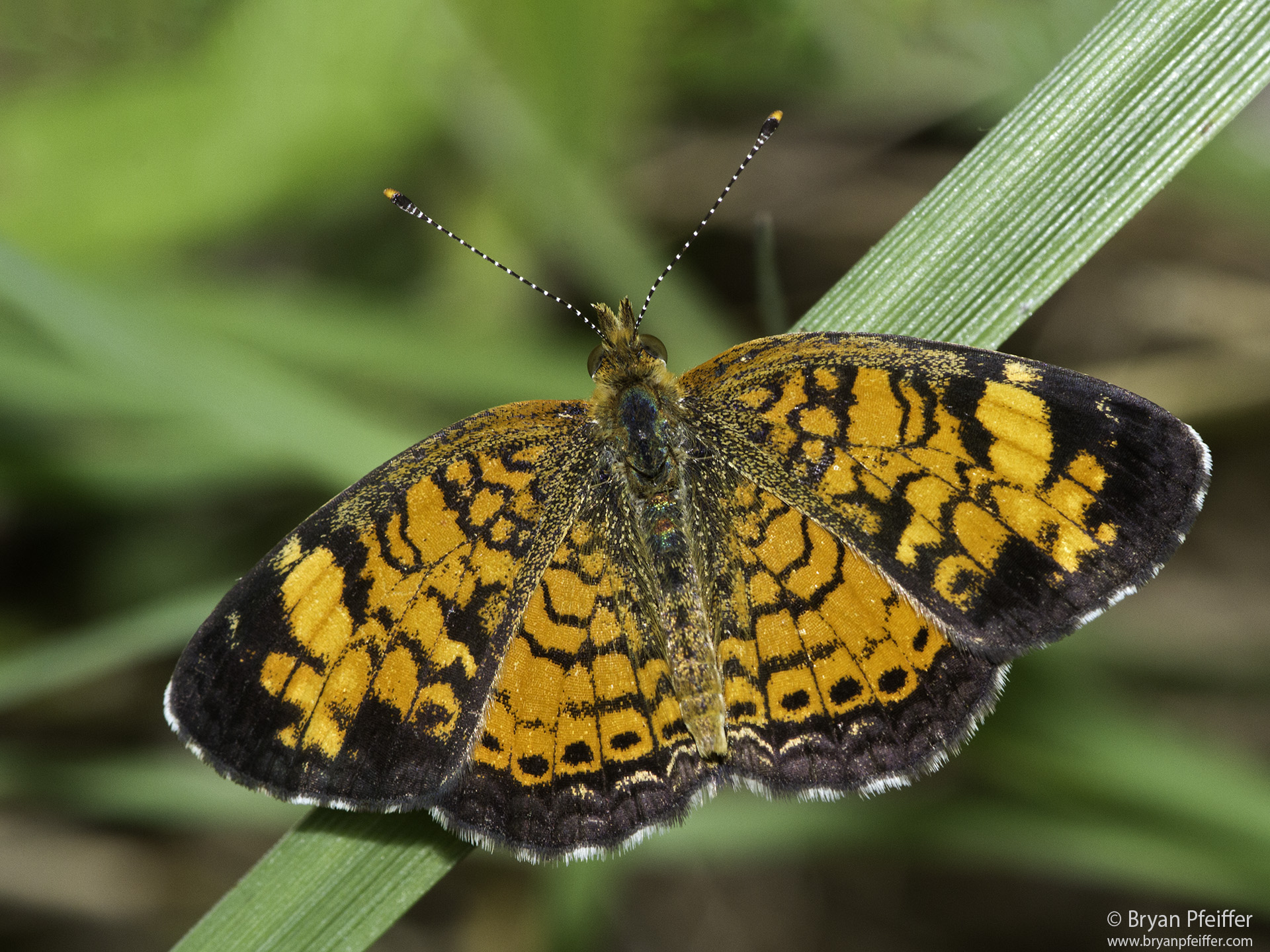
The Virtue in Uncertainty
Photo: Northern Crescent / Vermont / 31 May 2012
One of the best things about nature is that even seasoned biologists and naturalists sometimes have no clue what’s living our own backyards — even when we’re told otherwise (especially when we’re told it on the internet). So I now present to you a gossamer reminder that in nature, as in all life, there are often no easy answers, which can be a very good thing.
Meet the Pearl Crescent (Phyciodes tharos), among the most widespread and abundant butterflies across the eastern United States. Actually, if you live nearly anywhere in the US or much of Canada you are now not too far from this lovely butterfly or one of its relatives. And yet across a sizable swath of the continent, one of Pearl Crescent’s in-laws, Northern Crescent (Phyciodes cocyta), complicates the lives of even skilled lepidopterists. As these two butterfly species float and flutter around us in abundance, we often cannot tell them apart.
This is a hard thing to accept for Homo sapiens (who might more appropriately be named Homo hubris). We like to think we know such charismatic “insecta-fauna” as butterflies, particularly because we also like to put names on things, especially on the more poetic creatures among us. I name therefore I am. I myself have nothing against naming, mind you. Not only does it bring order to the world, it also brings, at least to me, a kind of constitutional satisfaction — an intrinsic sense of fulfillment. Knowledge is human nature, after all. Especially knowledge of nature.
And yet we can’t always name the crescents posing for us in plain view, which seems, well, unnatural. Our not being able to tell a Pearl Crescent from a Northern Crescent is a bit like a birdwatcher not knowing whether that putative American Robin pulling up earthworms in the yard is in fact an American Robin. Our world becomes unsettled, uncertain (surprise, surprise).
Even so, I welcome the unknown. One of the reasons I treasure crescents is that they can be tranquil or pugnacious or indifferent — four wings and multiple personalities. Males might be fluttering about your knees in one moment, chasing a female the next, or just sitting there with other males on dirt roads sipping nutrients like businessmen at a three-martini lunch. Females spend a good portion of their day floating around, nectaring on flowers, laying eggs, and avoiding those pugnacious males.
The real reason I treasure crescents is for the uncertainty in their identity.
But I think that the real reason I treasure crescents is for the uncertainty in their identity. Uncertainty breeds inquiry — at least among those of us with the temerity to explore and learn and find gifts among the prosaic. For the last few days the season’s first crescents have been on the wing here in my yard on a hillside in central Vermont. I have it on good authority, and a fair amount of my own study, that these are in all likelihood Northern Crescents. It would be easy for me to believe that I recognize them, that I can check them off as known, vanquished, and then move on to the checkerspots or swallowtails freewheeling among the flowers here in the garden.
And yet I can’t help but think I might be wrong about my backyard crescents. Or maybe I’m right most of the time and wrong some of the time. So I sit with them, watch them go about their business on the buttercups and phlox. And even if my catalogue of knowledge about these butterflies escapes me, when it all might fall apart, and when I find myself lost among them, well, hey, I’m lost among butterflies. Unlike the regrettable practice in birdwatching, I am not checking off this butterfly and moving on to what’s next.
Among my crescents there is no what’s next. No email to check, no virus to avoid, no president to defeat in November, no certainty in the future. Only a little orange-and-black butterfly and its multitudes: the patterns on the upper (dorsal) side of its wings, the pale crescent within a darkened patch on its tawny ventral hindwing, the color on the underside of its antenna club, even the way it flaps and glides and rests.
As it turns out, I began writing this essay Saturday evening with another objective in mind: to describe for students in my online butterfly class all the reliable and unreliable field marks in the pantheon of crescent identification. (It is the females of these two crescents that are most often unidentifiable in the field or even with a good photograph; and there might even be a third crescent species in the mix here, Phyciodes diminutor, which I don’t believe has a common name.) But now, Sunday morning, 700 words later, I still haven’t written down those field marks. Maybe I’ll write them later in another blog post or handout. At 10am today, the sun has forced its way into my day; the air is crisp and clear and comfortable.
Any minute now, the crescents will be taking flight.


Lovely, Bernie! Thanks!
Hi Jeremy, The insect records are, well, complicated. It’s not like bird records committees. And it varies greatly from state to state, complicated even more so by unsettled taxonomy. Such is the nature of the class Insecta — so much diversity, sometimes beyond our grasp. 🙂
Hi Zara — sorry about my belated reply on this. Check out Window Skimmer for your dragonfly!
Uncertainty is only trumped by No Clue, in the Department of Glee for me. Which means I’m constantly giddy with curiosity! Not that dunceness is a goal, of courses. Take yesterday – I stood transfixed watching a dragonfly, the first of the season in inner city Boston, blissfully clueless of what to call it. Figured I could find it among your pictures. Couldn’t.
Maybe you consummate namers can enlighten me. Clear wings, except for a black, half inch square on each wing. It made it appear to have straight-ended wings, though aerodynamics might say the tips were clear and rounded beyond the black boxes. It was busy catching every insect that flew up in the garden. It’s body looked to brown and beige striped (crosswise). And I may have seen a flash of orange on one of it’s liftoffs. Your turn. Happy physical distancing!
Them dang Crescents! My policy is shoot first, ask questions later, I got a lot a pictures and I’m still questioning. Perhaps they mix a bit a on the gradient north just to play with us namers.
Northern Crescent is shown as occurring throughout VT and NY including Long Island. There are records right on the VT/MA border in the western part of these states. Yet, none in MA or CT for that matter (see Butterflies and Moths of North America https://www.butterfliesandmoths.org/species/Phyciodes-cocyta.)
I am not familiar with how records are accepted in various states but this seems as though it would be a decision based on opinions/decisions of state committees, and approval of records in MA and CT, as opposed to a lack of reports from these 2 southern NE states. Comments?
Oh dear, dear sweet backyard. How I have neglected you. Starved you of your native diet, allowing mostly barren grass to grow upon your tired soils. I have rarely visited you except to drive an ear-splitting gas spewing mower about your back.
AH, but now the virus has cornered me. With a shortened leash I have little choice but to visit, to wander, to explore my own small but always welcoming backyard.
I now have time and interest to plant native plants especially those that sustain the food web by feeding essential caterpillars and other insects. I am thrilled to help sustain natures functional ecosystem that supports all life – right here at home. I can be part of small efforts by lots of people to help our soil and ecosystems recover.
Now every day I follow the paths (only areas I mow now) and find more butterflies, dragonflies, beetles, pollinating flies and wasps, predatory insects, and more all in you – my overlooked backyard.
She welcomes me home, and wonders where I have been all this time.
Bernie
Read my Vermont Native Plants and their Visitors at https://jerichovermont.blogspot.com/2020/06/vermont-native-plants-their-visitors.html
Mental juggling and uncertainty — yeah, they go well together! 🙂
Very kind of you. Thanks, Yvonne!
Yes, Bryan, not knowing for sure… sometimes is the spice of life… I think; it leads to more exploring, more curiosity and more comparing.
We are trying to make sense of it all… sometimes never arriving to any satisfying answer… So we go on and on and that is what makes life so interesting to us Homo sapiens. Thank you as always, for a thoughtful, wonderful piece about life and nature, Bryan.
Thanks for this– looking forward to those field marks, even if they just add to the mental juggling and uncertainty.
Yep, gotta love them! As you well know. And with skippers, I guess we love them as a lifelong adventure in learning.
… and will practice the warblers shall come to you, Carolyn! 🙂
Oh, what a wonderful crescent, those Phaons. I would welcome them here in the north! (I don’t suppose you call them “cute” down there by any chance?)
I feel this way about warblers. On the rare occasions I see them, it’s never long enough to observe enough detailed characteristics that I can identify the bird from a book. But I feel virtuous just knowing that I know enough to recognize a warbler, and feel glad for having had the opportunity.
How do you cope with all your Skippers? We have two that can only be told apart by the colour of the antenna tip and a slightly different shaped sex brand. Just got to love butterflies!
Until they turn to Phaon Crescents.
Well, the real challenge is identifying female crescents. And what I’ll have to say about it all in class, particularly during our first meeting, will be to let them be — just call them crescents for now. I’d rather see students now being able to readily tell a Harris’ or Silvery checkerspot, even on the wing, from a crescent than to work out all the details of Pearl/Northern crescent identification. But I’m thrilled you had the debate yesterday, Jennifer! 🙂
Or just call them crescents — that’s absolutely fine! 🙂
Always good to have a second look!
Down there they are all Pearl Crescents! 🙂
I posted on I-Naturalist a pearl crescent yesterday after much debate with myself on whether it could be a northern. I’ve looked at the post again and I’m back to dithering about it! If uncertainty is a virtue, I’m feeling very virtuous. Will be interested to hear what you have to say about crescents in class.
Now I need to take a second look at the Pearly cresent!
On the ADK side, we thought we were looking at Tiger swallowtails …now will have to take a second look!!
This is so timely Bryan, because just today, we have been having a friendly debate over who is correct in identifying a particular Crescent!